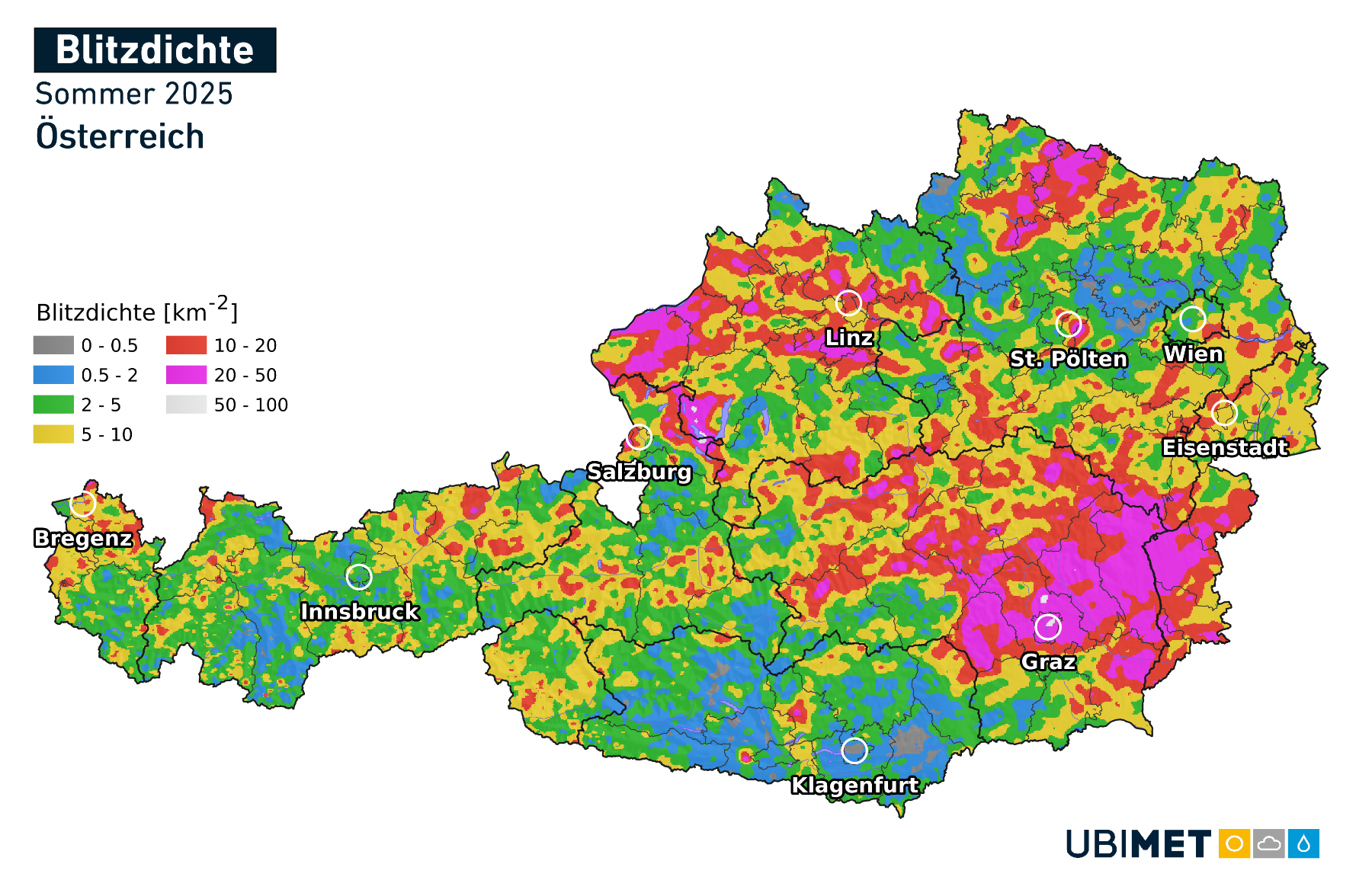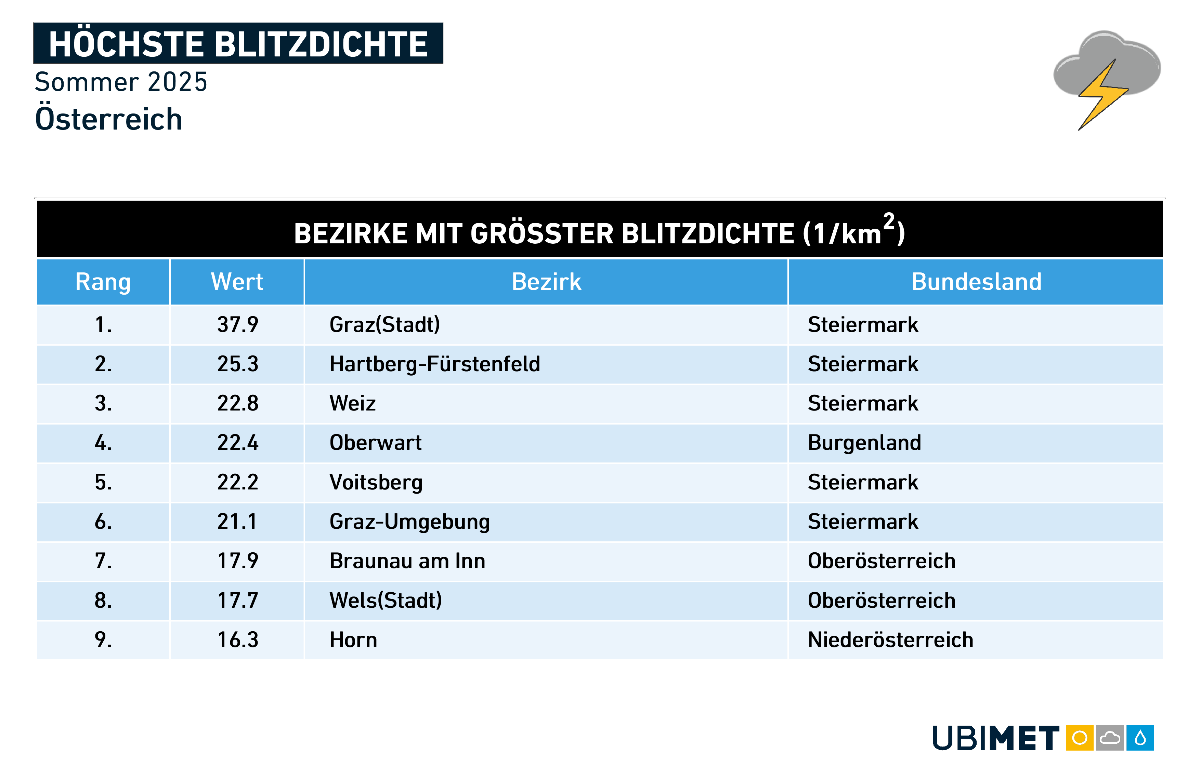In August, only a single lightning strike in Vienna: Thunderstorm season was a total failure across Austria
From June 1 to August 31, 2025, 669,464 lightning discharges were recorded in Austria. According to weather experts from the Austrian Severe Weather Center (www.uwz.at), this year's thunderstorm season is among the weakest since records began: a total of 44 percent fewer lightning strikes were recorded than usual. The highest lightning density was recorded in Graz.
Thunderstorm Season Significantly Below Average
In the summer of 2025, the lightning detection system from nowcast, the lightning specialist of the
UBIMET group, recorded exactly 669,464 lightning strikes across Austria (cloud-to-cloud and cloud-to-ground lightning). “This year's
thunderstorm season is significantly below average, only the summer of 2015 was comparably
lightning-poor,” analyzes Nikolas Zimmermann, meteorologist at the Austrian Severe Weather Center.
For comparison: in the particularly stormy summer of 2024, with 1.5 million lightning strikes,
more than twice as many discharges were counted.

Styria Led in Terms of Lightning
The highest lightning density of 13 discharges per km² was measured in Styria, followed
by Burgenland with 12.4 and Upper Austria with 10.1. Carinthia ranks last with an average of only 3.2
lightning strikes per km².
On a district level, Styria also leads: “The district with the highest lightning density was
Graz with 38 lightning strikes per square kilometer,” says Zimmermann. In second and third place are
the districts of Hartberg-Fürstenfeld with 25 and Weiz with 23 discharges per square kilometer. The
first districts outside of Styria are found in ranks 4, 7, and 9: Oberwart (Burgenland) with 22 lightning strikes/km² in 4th place, Braunau am Inn (Upper Austria) with 18 lightning strikes/km²
in 7th place, and Horn (Lower Austria) with 16 lightning strikes/km² in 9th place. The most lightning-rich days of the summer were June 26 with 138,000 discharges and June 23 with 94,000.

Lightning-Richest Months July and August Were a Lull
The month with the most lightning this year was June with 358,000 discharges – a value that corresponds to the long-term monthly average. After that, the thunderstorm season almost came to a screeching halt: "Ironically, during the otherwise most lightning-rich time of the year, activity was significantly below average," said Zimmermann. In July, 209,000 lightning strikes were recorded – a decrease of over 50 percent compared to the average. The balance in August was even poorer: with only 103,000 discharges, the decrease was around 70 percent. In the past 15 years, only August 2015 had fewer lightning strikes.
A particularly drastic example is Vienna: throughout August, only a single lightning strike was recorded there. Such a total failure in August is unprecedented. For comparison: usually, around 1,500 discharges occur in the federal capital during this month.
Unfavorable Weather Conditions for Summer Thunderstorms
Responsible for the unusually low lightning activity in midsummer was a sequence of unfavorable large-scale weather patterns: temporary high-pressure influence with dry air was interrupted by a longer low-pressure phase in July, but with a maritime, low-energy air mass. This combination often resulted in unfavorable conditions for the formation of strong thunderstorms. "Especially large-scale thunderstorm systems, which normally bring many lightning strikes, were largely absent this year," said the expert.
Strongest Lightning Measured in Tyrol
The strongest lightning in the country was measured in Tyrol: the leader is a discharge with around 288,000 amperes on June 21 in the municipality of Sölden. This corresponds to the current of about 18,000 household sockets, each operating simultaneously at their maximum load of 16 amperes. Contrary to popular belief, the current of a single lightning strike says little about the strength of a thunderstorm. Strong lightning often occurs in the mountains or during comparatively harmless cold air thunderstorms.
(Red)
This article has been automatically translated, read the original article here.





